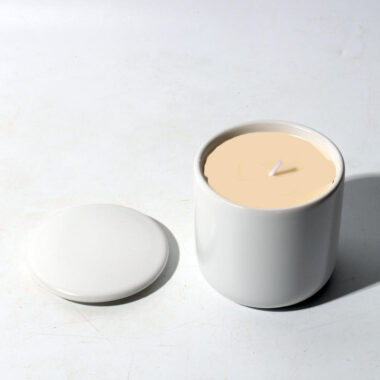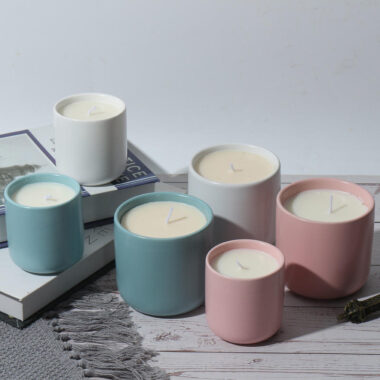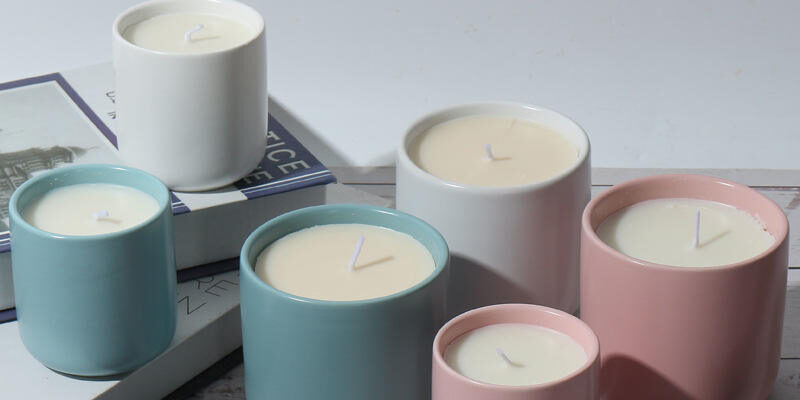🔍 Why Vessel Choice Matters
When sourcing or developing a candle line, many brands focus on fragrance or wax quality but underestimate the vessel’s role. In reality, the candle jar determines heat distribution, wick performance, and overall safety. Choosing the right jar for each wax and wick combination is critical to ensuring your product burns evenly, avoids tunneling, and passes compliance tests.
By understanding how jar materials, thickness, and dimensions interact with different waxes and wick types, you can minimize costly production issues and enhance end-user satisfaction.
🏺 Material Considerations: Glass, Ceramic, and Beyond
-
Glass Candle Jars: Transparent, versatile, and widely preferred for retail because customers can see the wax color. They handle most paraffin and soy blends well, provided you manage thermal shock resistance.
-
Ceramic Candle Jars: Opaque and heavier, ideal for premium or luxury lines. They retain heat differently, often requiring wick adjustment to prevent overheating.
-
Metal Tins: Portable, lightweight, and budget-friendly. They cool quickly but limit fragrance throw compared to thicker vessels.
👉 Brands sourcing in volume often explore material variations within a wholesale program such as Candle jar wholesale, ensuring consistent supply while balancing cost tiers.
🔥 Wick Diameter and Jar Opening
The opening diameter of the jar directly influences wick size and burn pool.
-
Narrow Openings: Need smaller wicks or cotton-core designs to avoid oversized flames.
-
Wide Mouths: Often require dual or triple wicks to ensure full surface melt and prevent tunneling.
-
Deep Jars: Thicker glass walls demand higher heat wicks or larger diameters to keep wax pools even.
A mismatch between wick and jar geometry leads to poor performance, excessive soot, or safety hazards.
🧪 Burn Testing and Compliance
Every vessel-wax-wick combination must undergo thorough burn testing before approval. Factors to test include:
-
Flame height consistency over the full burn cycle.
-
Soot and mushrooming at mid-life of the candle.
-
Maximum surface temperature of the vessel exterior.
-
Extinguishing behavior when wax reaches end-of-life.
Factories with standardized testing protocols reduce the risk of recalls and strengthen brand reputation.
🎨 Shape, Finish, and Brand Storytelling
Beyond function, the jar’s shape and finish influence how consumers perceive your candle.
-
Straight-Sided Jars: Easier to fill and label, popular in mass retail.
-
Curved or Tapered Jars: Premium appeal, but require more careful filling and wicking adjustments.
-
Finishes: Frosted glass diffuses light softly, while electroplated interiors create a reflective flame effect.
For brands leaning into visual differentiation, working with a trusted Glass Candle Jar Manufacturer ensures consistent finish quality across large orders.
📦 MOQ and Supply Chain Planning
Selecting a jar is not only about technical fit but also about supplier capacity. Lead times, MOQs, and carton configurations should align with your forecast. For example:
-
Fast-moving SKUs: Require larger MOQs to secure continuous flow.
-
Seasonal launches: May benefit from flexible suppliers who can offer smaller trial runs.
-
Export markets: Need sturdy packaging and pallet standards to reduce breakage during transit.
When integrated into procurement planning, the right candle jar ensures predictable cost, on-time deliveries, and smooth restocking cycles.
✅ Final Thoughts
Candle jars are more than decorative containers—they are central to performance, safety, and branding. By carefully matching jar material, shape, and finish with your wax and wick system, you create a reliable product that delights customers and minimizes quality risks.
If you are preparing your next range, consider both the technical fit and the storytelling impact of the vessel. A well-chosen jar elevates not only the candle but your entire brand image.









